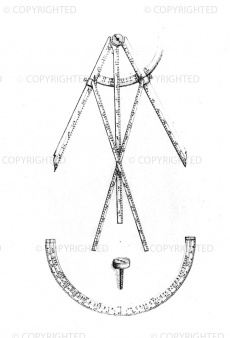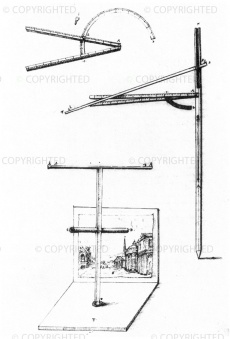Surveying Compasses
From Inventions
| Line 27: | Line 27: | ||
|immagini= | |immagini= | ||
| + | |||
| + | <gallery widths=230 heights=368 perrow=3> | ||
| + | |||
| + | Image: 56700.jpg | Giacomo Contarini. ''Figure d'Istromenti Matematici'', Oxford, c. 1590, c25.<br /> | ||
| + | |||
| + | Image: 56701.jpg | Giacomo Contarini. ''Figure d'Istromenti Matematici'', Oxford, c. 1590, c39.<br /> | ||
| + | |||
| + | </gallery> | ||
| + | |||
| + | |||
| + | |||
|autore_scheda= Filippo Camerota | |autore_scheda= Filippo Camerota | ||
Current revision as of 08:21, 10 September 2010
Current name for a surveying instrument widely used in Renaissance times.
Contents |
Historic Period
16th-17th C.
Description
Compass used for surveying, generally consisting of two flat graduated legs, a magnetic compass in the hinged joint and sighting devices. In its simplest form, this type of compass is well represented by the so-called florentine archimeter. In a version described by Giacomo Contarini, which may have been invented by Fabrizio Mordente, the instrument has two graduated legs with a magnetic compass in the joint, a graduated arm also pivoted at the joint, two small graduated arms connected to cursors sliding along the legs, and a 180° graduated arc.
Bibliographical Resources
Contarini, Giacomo. Figure d'Istromenti Matematici e loro uso, ms, ca. 1590, Oxford, Bodleian Library, Ms. Canon. Ital. 145.
Existing Instruments
- Museo Galileo, Institute and Museum of the History of Science, Florence
Florence, Museo Galileo. Istituto e Museo di Storia della Scienza, Inv. 645.
Florence, Museo Galileo. Istituto e Museo di Storia della Scienza, Inv. 1280.
Florence, Museo Galileo. Istituto e Museo di Storia della Scienza, Inv. 1471.
Florence, Museo Galileo. Istituto e Museo di Storia della Scienza, Inv. 3687.
Florence, Museo Galileo. Istituto e Museo di Storia della Scienza, Inv. 2527.
Images
Author of the entry: Filippo Camerota


